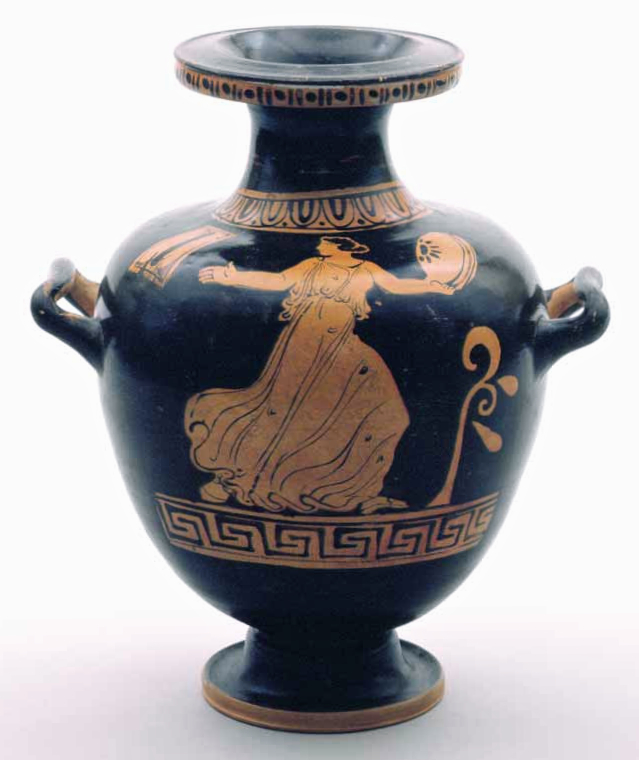

Title: Ancient Mediterranean Pottery Woman Of Pleasure Red-Figure Hydria
Shipping: $29.00
Artist: N/A
Period: Antiquity
History: N/A
Origin: Southern Europe > Italy
Condition: Museum Quality
Item Date: 400 BC to 300 BC
Item ID: 6416
Apulian Red-Figure Hydria Mediterranean: Origin: Mediterranean Circa: 400 BC to 300 BC Dimensions: 10.875" (27.6cm) high Catalogue: V1 Collection: Classical Medium: Terracotta: A symphony of graceful, flowing movement, this running woman is perhaps a Maenad ("the possessed"), one of the female followers of Dionysus. Looking at this exquisite vessel, we imagine some flesh-and-blood woman long ago whirling to the beat of her tambourine and seized with the ecstasy of the god. In the presence of this lovely work of art, we are transported through time to a vanished world full of color, sound, and motion. If we close our eyes, the dancer comes alive and whirls round and round in the grip of Dionysiac pleasure.
Link: http://en.wikipedia.org/wiki/Apulian
Apulia is one of the richest archaeological regions in Italy. It was first colonized by Mycenaean Greeks. At the 8th century BC, the Ancient Greeks expanded until reaching the area of Taranto and Salento in Magna Graecia. In the 5th and 4th centuries BC, the Greek settlement at Taras produced a distinctive style of pottery (Apulian vase painting).
Apulia was an important area for the ancient Romans, who conquered it during the course of wars against the Samnites and against Pyrrhus in the 4th and 3rd centuries BC but also suffered a crushing defeat here in the battle of Cannae against Hannibal. However, after the Carthaginians left the region, the Romans captured the ports of Brindisi and Taranto, and established dominion over the region. During the Imperial age Apulia was a flourishing area for production of grain and oil, becoming the most important exporter to the Eastern provinces.
After the fall of Rome, Apulia was held successively by the Goths, the Lombards and, from the 6th century onwards, the Byzantines. Bari became the capital of a province that extended to modern Basilicata, and was ruled by a catepano (governor), hence the name of Capitanata of the Barese neighbourhood. From 800 on, a Saracen presence was intermittent, but Apulia remained under the Byzantine authority, despite the region being mainly inhabited by Lombards until the 11th century, when the Normans conquered it with relative ease.
Robert Guiscard set up the Duchy of Apulia in 1059. After the Norman conquest of Sicily in the late 11th century, Palermo replaced Melfi (just west of present day Apulia) as the center of Norman power.
From the late 12th to early 13th centuries, it was a favorite residence of the Hohenstaufen emperors, notably Frederick II. A number of castles were built in the area by Frederick, including Castel del Monte.
In 1734 there were the battle of Bitonto, a Spanish victory over Austrian forces. The coast was occupied at times by the Turks and by the Venetians. When Barbary pirates of North Africa sacked Vieste in 1554 they took an estimated 7,000 slaves. The French also controlled the region in 1806–15, resulting in the abolition of feudalism and the reformation of the justice system.
In 1861 the region became part of the Kingdom of Italy.
Apulia (Italian: is a region of Italy in Southern Italy bordering the Adriatic Sea in the east, the Ionian Sea to the southeast, and the Strait of Òtranto and Gulf of Taranto in the south. Its southernmost portion, known as Salento peninsula, forms a high heel on the "boot" of Italy. The region comprises 19,345 square kilometers (7,469 sq mi), and its population is about 4.1 million. It is bordered by the other Italian regions of Molise to the north, Campania to the west, and Basilicata to the southwest. It neighbors Albania, Bosnia-Herzegovina, Croatia, Greece, and Montenegro, across the Adriatic and Ionian Seas, respectively. The region extends as far north as Monte Gargano. Its capital city is Bari.